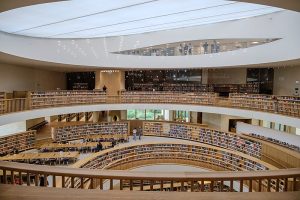Since October 7, 2023, following the Hamas attack on Israel and the war in Lebanon, the incoming tourism sector (international tourists) has come to an almost complete standstill. Naturally, I am not working as a tour guide at the moment.
In every tourism crisis, tour guides need to “reinvent themselves.” During such crises, I grow my family (Carmel was born during the pandemic, and Yuval was born in May 2024) and look for opportunities to guide locally, whether in a museum or an archaeological site.
In September 2024, I completed the training course for guiding at the new National Library of Israel, and since then, I have been working there as a guide. If you’ve been to Israel multiple times and have seen all the major highlights (or even if you haven’t), I recommend visiting the National Library.
I emphasize a few recurring themes in every tour, whether for international tourists or locals. One of them is that Zionism is an evolving idea. Each generation defines Zionism differently. For different individuals, Zionism has meant distinct things: reviving the Hebrew language, establishing Hebrew theater (like Habima), making the desert bloom, or founding a kibbutz. The creation of the National Library is another such Zionist act.
Jews from Eastern Europe who were members of organizations known as Hovevei Zion (the precursors to the Zionist movement) believed that if European nations had national libraries, perhaps it was a good idea for Jews to have their own. If the England and France had national libraries, why shouldn’t we?
They said it—and they did it. The B’nai B’rith organization established the first National Library in 1892, marking 400 years since the expulsion from Spain, in Jerusalem. Dr. Yosef Hazanovitz, a physician and book lover, would often accept books as payment from patients who couldn’t afford medical fees. He eventually sent his extensive collection to the library in Jerusalem.
In 1925, the library moved to the Hebrew University on Mount Scopus, serving as both the national and academic library until 1948. After the War of Independence, the library’s collections were scattered throughout the western part of the city until 1960, when they were moved to the Safra Campus of the Hebrew University. However, being located inside the university campus, the library wasn’t easily accessible to the general public, serving primarily university visitors.
In 2007, the Israeli Knesset passed the National Library Law, transforming the library into an independent, apolitical entity. This law marked the “separation” from the Hebrew University.
The grand opening of the new National Library building was originally scheduled for October 17, 2023. However, in the wake of the Hamas attack, the library was uncertain about proceeding. Ten days after the planned opening date, the library opened its doors, and since then, hundreds of users and visitors have been coming daily.
The National Library of the Jewish People collects and preserves the treasures of Jewish heritage, the State of Israel, and the Land of Israel. It houses over 8 million items, including books, manuscripts, a music collection, and archives. The library features a stunning visitors’ center and a fascinating permanent exhibition. Its collections are divided into five main categories:
- The Israel Collection
- The Jewish Collection
- The Islam and Middle East Collection
- The Humanities Collection
- The Music Collection
The new building was designed by Herzog & de Meuron from Switzerland, with the surrounding gardens planned by Michal Yariv. Located in the heart of the National District in Jerusalem, the building’s architecture, its artworks, and the Otiyot Or (Light Letters) sculpture inspire all who visit.
Don’t miss the robotic book storage, the Damascus Crown, and the emotional exhibit dedicated to hostages.
Due to the high number of visitors, once you know your travel dates to Israel, do yourself a favor and book a spot for an English tour.
To reserve your place, National Library Tours

